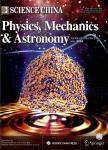Physics perspectives of heavy-ion collisions at very high energy
Physics perspectives of heavy-ion collisions at very high energy作者机构:Key Laboratory of Quark and Lepton Physics (MOE) and Institute of Particle Physics Central China Normal University Wuhan 430079 China Nuclear Science Division MS70R0319 Lawrence Berkeley National Laboratory Berkeley 94720 USA Physics Department Tsinghua University Beijing 100084 China Department of Applied Physics Nanjing University of Science and Technology Nanjing 210094 China Cyclotron Institute and Department of Physics and Astronomy Texas A&M University College Station TX 77843 USA Physics Department Brookhaven National Laboratory Upton New York 11973 USA Department of Physics McGill University Montreal Quebec H3A 2T8 Canada Department of Physics and State Key Laboratory of Nuclear Physics and Technology Peking University Beijing 100871 China Department of Modern Physics University of Science and Technology of China Hefei 230026 China
出 版 物:《Science China(Physics,Mechanics & Astronomy)》 (中国科学:物理学、力学、天文学(英文版))
年 卷 期:2016年第59卷第2期
页 面:1-27页
核心收录:
学科分类:083001[工学-环境科学] 0830[工学-环境科学与工程(可授工学、理学、农学学位)] 08[工学] 0827[工学-核科学与技术] 082701[工学-核能科学与工程]
基 金:the National Natural Science Foundation of China(Grant Nos.11175071,11221504,11305089,11322546,11375072,11435001 and 11435004) China MOST(Grant Nos.2014DFG02050 and2015CB856900) the Major State Basic Research Development Program in China(Grant Nos.2014CB845404 and 2014CB845403) the Natural Sciences and Engineering Research Council of Canada the US National Science Foundation(Grant No.PHY-1306359) the Director,Office of Energy Research,Office of High Energy and Nuclear Physics,Division of Nuclear Physics,of the U.S.Department of Energy under Contract Nos.DE-AC02-05CH11231,DE-SC0012704 within the framework of the JET Collaboration BJS is also supported by a DOE Office of Science Early Career Award
主 题:quark-gluon plasma heavy-ion collisions QCD phase transition properties of QGP
摘 要:Heavy-ion collisions at very high colliding energies are expected to produce a quark-gluon plasma(QGP) at the highest temperature obtainable in a laboratory setting. Experimental studies of these reactions can provide an unprecedented range of information on properties of the QGP at high temperatures. We report theoretical investigations of the physics perspectives of heavy-ion collisions at a future high-energy collider. These include initial parton production, collective expansion of the dense medium, jet quenching,heavy-quark transport, dissociation and regeneration of quarkonia, photon and dilepton production. We illustrate the potential of future experimental studies of the initial particle production and formation of QGP at the highest temperature to provide constraints on properties of strongly interaction matter.



